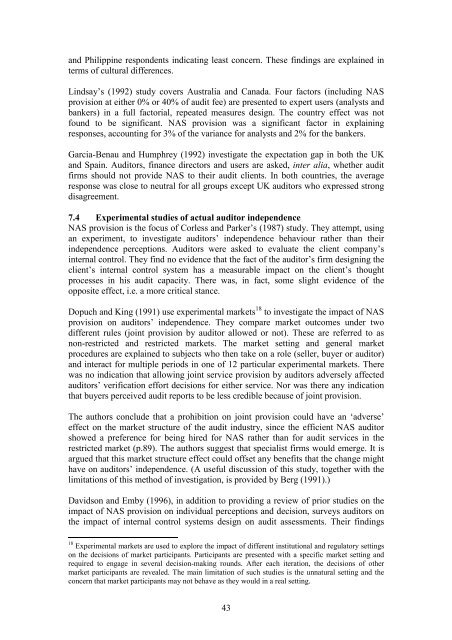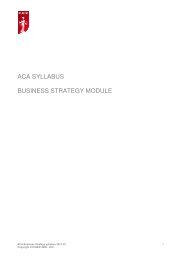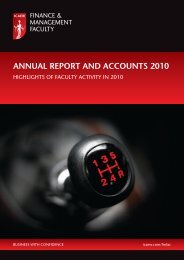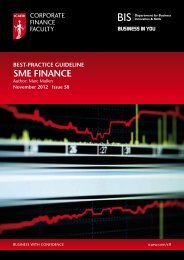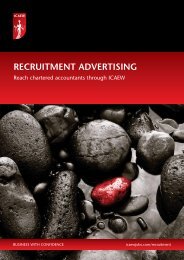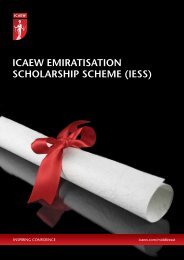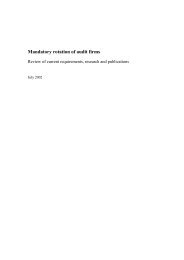Auditor independence and non-audit services - ICAEW
Auditor independence and non-audit services - ICAEW
Auditor independence and non-audit services - ICAEW
You also want an ePaper? Increase the reach of your titles
YUMPU automatically turns print PDFs into web optimized ePapers that Google loves.
<strong>and</strong> Philippine respondents indicating least concern. These findings are explained interms of cultural differences.Lindsay’s (1992) study covers Australia <strong>and</strong> Canada. Four factors (including NASprovision at either 0% or 40% of <strong>audit</strong> fee) are presented to expert users (analysts <strong>and</strong>bankers) in a full factorial, repeated measures design. The country effect was notfound to be significant. NAS provision was a significant factor in explainingresponses, accounting for 3% of the variance for analysts <strong>and</strong> 2% for the bankers.Garcia-Benau <strong>and</strong> Humphrey (1992) investigate the expectation gap in both the UK<strong>and</strong> Spain. <strong>Auditor</strong>s, finance directors <strong>and</strong> users are asked, inter alia, whether <strong>audit</strong>firms should not provide NAS to their <strong>audit</strong> clients. In both countries, the averageresponse was close to neutral for all groups except UK <strong>audit</strong>ors who expressed strongdisagreement.7.4 Experimental studies of actual <strong>audit</strong>or <strong>independence</strong>NAS provision is the focus of Corless <strong>and</strong> Parker’s (1987) study. They attempt, usingan experiment, to investigate <strong>audit</strong>ors’ <strong>independence</strong> behaviour rather than their<strong>independence</strong> perceptions. <strong>Auditor</strong>s were asked to evaluate the client company’sinternal control. They find no evidence that the fact of the <strong>audit</strong>or’s firm designing theclient’s internal control system has a measurable impact on the client’s thoughtprocesses in his <strong>audit</strong> capacity. There was, in fact, some slight evidence of theopposite effect, i.e. a more critical stance.Dopuch <strong>and</strong> King (1991) use experimental markets 18 to investigate the impact of NASprovision on <strong>audit</strong>ors’ <strong>independence</strong>. They compare market outcomes under twodifferent rules (joint provision by <strong>audit</strong>or allowed or not). These are referred to as<strong>non</strong>-restricted <strong>and</strong> restricted markets. The market setting <strong>and</strong> general marketprocedures are explained to subjects who then take on a role (seller, buyer or <strong>audit</strong>or)<strong>and</strong> interact for multiple periods in one of 12 particular experimental markets. Therewas no indication that allowing joint service provision by <strong>audit</strong>ors adversely affected<strong>audit</strong>ors’ verification effort decisions for either service. Nor was there any indicationthat buyers perceived <strong>audit</strong> reports to be less credible because of joint provision.The authors conclude that a prohibition on joint provision could have an ‘adverse’effect on the market structure of the <strong>audit</strong> industry, since the efficient NAS <strong>audit</strong>orshowed a preference for being hired for NAS rather than for <strong>audit</strong> <strong>services</strong> in therestricted market (p.89). The authors suggest that specialist firms would emerge. It isargued that this market structure effect could offset any benefits that the change mighthave on <strong>audit</strong>ors’ <strong>independence</strong>. (A useful discussion of this study, together with thelimitations of this method of investigation, is provided by Berg (1991).)Davidson <strong>and</strong> Emby (1996), in addition to providing a review of prior studies on theimpact of NAS provision on individual perceptions <strong>and</strong> decision, surveys <strong>audit</strong>ors onthe impact of internal control systems design on <strong>audit</strong> assessments. Their findings18 Experimental markets are used to explore the impact of different institutional <strong>and</strong> regulatory settingson the decisions of market participants. Participants are presented with a specific market setting <strong>and</strong>required to engage in several decision-making rounds. After each iteration, the decisions of othermarket participants are revealed. The main limitation of such studies is the unnatural setting <strong>and</strong> theconcern that market participants may not behave as they would in a real setting.43


